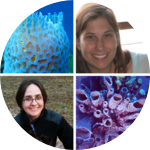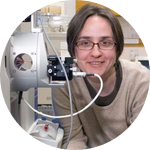Project Results
The results of this work demonstrate that sponges do in fact alter the availability of organic nutrients in seawater. More specifically, we found that as sponges pump seawater through their bodies, they release a higher concentration of some compounds (such as some amino acids) and a lower concentration of other compounds (including some vitamins) compared to the concentrations in the surrounding seawater. This exchange of dissolved nutrients represents a previously unknown connection between sponges and the rest of the coral reef community, and our results have prompted further investigations to better understand the role that sponges play in a healthy coral reef ecosystem.
About This Project
Sponges are nature's filtration systems; they can filter up to 50,000 times their own volume in a day. Changes to coral ecosystems from climate change make reef sponges increasingly important. This project takes one of the first steps to explore the impact of sponges on nutrient availability on coral reefs.
Contributions are tax deductible, and backers will get timely labnote field updates. We invite you to ask questions and connect with us directly in the comments - we'd love to hear from you!
Ask the Scientists
Join The DiscussionWhat is the context of this research?
- Many sponges are filled with diverse microbes (bacteria and small algae), which can comprise up to 40% of their volume. These microbes are considered symbionts of the sponge
- Sponges and their symbionts remove particles and dissolved organic nutrients from the water. These nutrients, or dissolved organic matter (DOM), are important in structuring microbial communities that are critical for maintaining a healthy reef
- There are also two different types of sponges on coral reefs: High Microbial Abundance (HMA) sponges and Low Microbial Abundance (LMA) sponges
- Do HMA and LMA sponges influence the water chemistry differently? How might this influence nutrient availability on the reef if sponges increase or decrease in abundance?
What is the significance of this project?
- We know that sponges take up organic matter
- We don't know how this organic matter is altered as it passes through a sponge and how this could influence the overall health of the coral reef
- This project will give us the first insight into addressing these questions and will provide novel information on coral reef nutrient dynamics to managers and conservation groups
- In our laboratory we have two instruments, called mass spectrometers, which allow us to measure the mass of molecules. This allows us to tell different types of molecules apart
- We use a 'targeted' and 'untargeted' method to identify compounds we know (targeted) and discover new compounds (untargeted)
- This will give us a never before seen snapshot of how nutrients are removed and regenerated on coral reefs
What are the goals of the project?
- Travel to the Smithsonian Marine Station Florida and to the FL Keys to collect water samples from a coral reef
- Samples are:
- water collected next to sponges ('ambient reef water')
- water collected from the 'excurrent plume' of 3 HMA and 3 LMA sponges
- water collected away from the reef ('off reef')
- Analysis of these four water sample types should give us the first indication of how sponges influence the composition of nutrients on the reef by comparing the 'ambient reef' water to the 'off reef' water
- We will also be able to see how HMA and LMA sponges differently impact nutrients on the reef by comparine the 'excurrent water' samples between these two
Budget
We will be working with a colleague at the Smithsonian Marine Station in Florida, which lowers the cost of sampling significantly. We only need to cover the cost of sample analysis using two mass spectrometers in our laboratory.
Sample analysis begins by extracting organic matter in the laboratory. Next the extracts will be analyzed on our two mass spectrometers to characterize the dissolved organic matter. One mass spectrometer will measure all compounds in a large mass range: 100 - 1000 Daltons, which includes most of the 'small' compounds that are important nutrients for many organisms. This is the "untargeted" method of organic matter characterization.
The second mass spectrometer allows us to identify and quantify known compounds. We call this the "targeted" method of organic matter characterization.
These complementary methods will provide novel information on coral reef nutrient dynamics that will be useful to scientists as well as managers and conservation groups.
Donations will be processed by Silicon Valley Community Foundation, a 501(c)(3) public charity registered in the state of California. Your gift is tax-deductible to the fullest extent of the law.
Meet the Team
Team Bio
Cara Fiore has worked on diverse research projects from invertebrate ecology to medical biology. Cara received a B.S. in biology from SUNY Cortland, and graduated from the College of Charleston (Grice Marine Lab) and the University of New Hampshire before starting a postdoc at WHOI. Cara spent 10 days underwater in the Aquarius Habitat during her graduate work - see the press & media section.Elizabeth Kujawinski is an associate scientist with tenure in marine chemistry at WHOI. Her research interests reside at the intersection of environmental chemistry and microbial ecology and she uses advanced analytical chemistry tools to answer questions about microbe-chemical interactions in aquatic systems. She received her PhD from the MIT/WHOI Joint Program in Oceanography and completed postdoctoral research at The Ohio State University. She has been at WHOI since 2004.
Cara Fiore
Dr. Cara Fiore has worked on diverse research projects from invertebrate ecology to medical biology. Cara received a B.S. in biology from SUNY Cortland, and graduated from the College of Charleston (Grice Marine Lab) and the University of New Hampshire before starting a postdoc at WHOI. Cara spent 10 days underwater in the Aquarius Habitat during her graduate work!
Elizabeth Kujawinski
Dr. Elizabeth Kujawinski is an associate scientist with tenure in marine chemistry at WHOI. Her research interests reside at the intersection of environmental chemistry and microbial ecology and she uses advanced analytical chemistry tools to answer questions about microbe-chemical interactions in aquatic systems. She received her PhD from the MIT/WHOI Joint Program in Oceanography and completed postdoctoral research at The Ohio State University. She has been at WHOI since 2004.
Press and Media

Additional Information
Meet the Kujawinski Lab: We are interested in ocean chemistry and more specifically, we study how microbes in the ocean interact with dissolved organic matter and what impact these interactions have on the cycling of globally important nutrients like carbon. To do this we collect samples from all over the world and analyze them on instruments (mass spectrometers) in the lab. Here are some photos from the field:Preparing to cast a CTD (Conductance Temperature and Depth) rosette over the side of the Research Vessel Knorr during a research cruise in the western Atlantic Ocean. We use this to collect data on the temperature, salinity, depth, and often other things like dissolved oxygen, of the water as it descends into the deep ocean. We can also collect water samples at specific depths using bottles on the rosette.
We are interested in ocean chemistry and more specifically, we study how microbes in the ocean interact with dissolved organic matter and what impact these interactions have on the cycling of globally important nutrients like carbon. To do this we collect samples from all over the world and analyze them on instruments (mass spectrometers) in the lab. Here are some photos from the field:Preparing to cast a CTD (Conductance Temperature and Depth) rosette over the side of the Research Vessel Knorr during a research cruise in the western Atlantic Ocean. We use this to collect data on the temperature, salinity, depth, and often other things like dissolved oxygen, of the water as it descends into the deep ocean. We can also collect water samples at specific depths using bottles on the rosette.


Project Backers
- 54Backers
- 100%Funded
- $3,000Total Donations
- $54.55Average Donation


